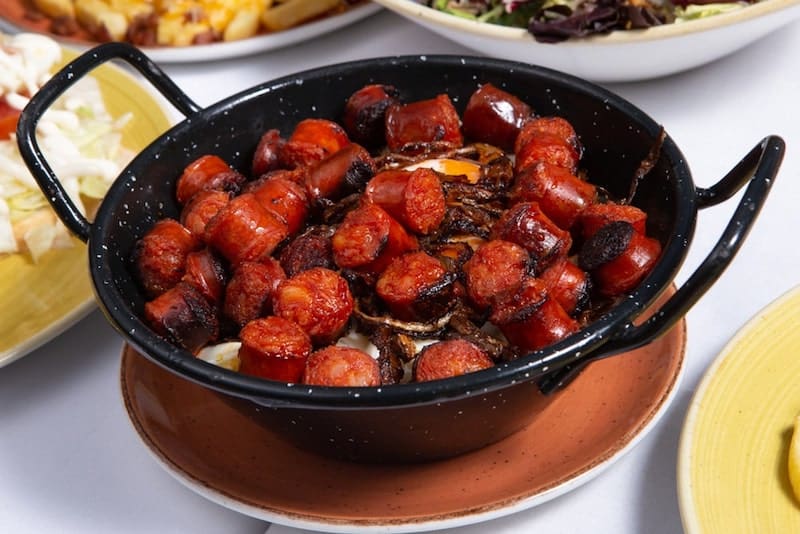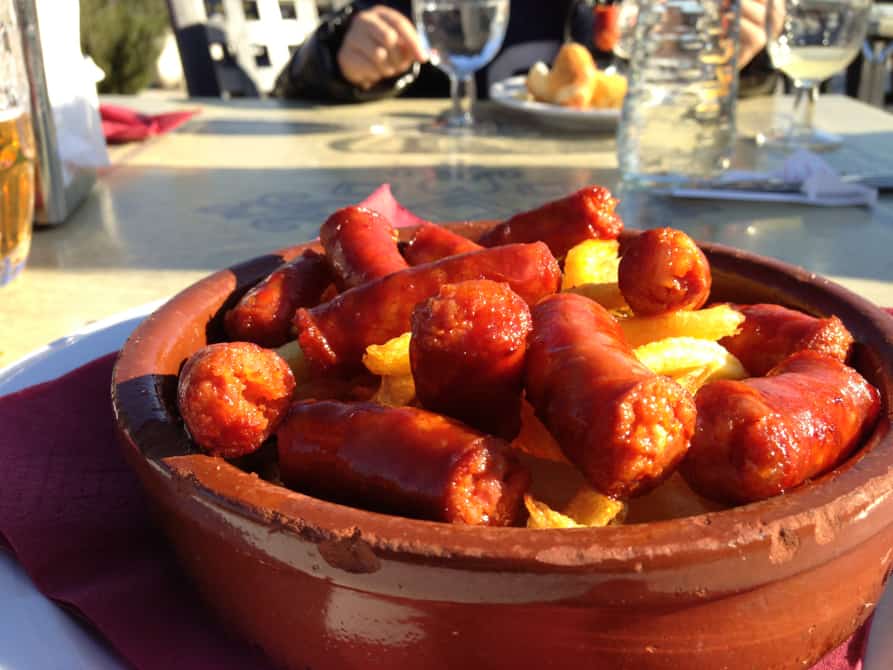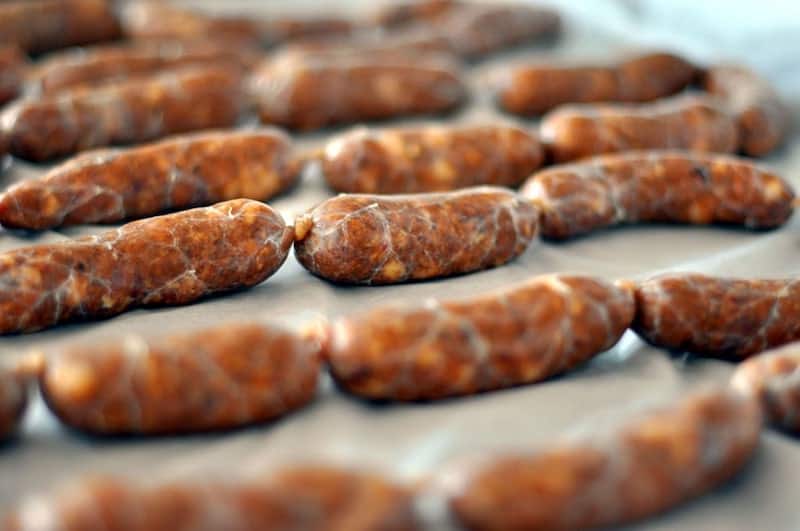Chistorra vs. Chorizo (Similarities and Differences Explained)
At first glance, chistorra is just another variety of delicious pork sausage, typically found in Basque cuisine. However, true foodies will know it’s never as simple as that.
Chistorra belongs to the same family as chorizo, and the two are often compared. To give an analogy of how they compare, it’s better to view them as sisters rather than twins.
The most significant distinction is the length of curing. Spanish chorizo is typically slow-cooked and air-dried for more extended periods. In contrast, chistorra is a semi-cured meat product, meaning it’s usually smoked for a couple of days.
Both sausages are a staple of Spanish cuisine, carrying traces of local culinary traditions in the flavor.
So, let’s settle the chistorra vs. chorizo debate by taking a deep dive into the curing process.

What is Chistorra?
Chistorra is a cured sausage that can be classified as a variety of chorizo. It’s a popular meat snack in the Basque country, particularly Spanish-Catalan regions such as Aragon and Navarra.
The sausage is traditionally made with ground pork or a mixture of ground beef and pork, seasoned with a blend of garlic, salt, and paprika.
Depending on the region, the meat mixture can vary. For example, chistorra Iberica is made from a pig head, lungs, and pancreas.
Like most chorizo sausages, it has a recognizable dark red color before and after cooking.
The meat is usually wrapped in lamb tripe and then fried, grilled, or even baked.
Compared to the standard Spanish chorizo, the links are typically thinner.
Several snacks and skewers include chistorra in the recipe. Since it’s a versatile ingredient, it works well with cooked dishes such as soups and stews. Of course, it can be served as a standalone course as well.
Chistorra is typically cooked whole, but it’s sliced into smaller pieces before frying as an appetizer. When fried, it’s best paired with wine (especially dry white wine like Txakoli) and beer.
During festivities, the sausage is commonly served with talo, the traditional Basquian corn tortilla. In some regions, chistorra is part of the feast in honor of Thomas the Apostle on December 21st.
A signature chistorra plate is huevos rotos con chistorra y patatas or fried eggs and potatoes. Other familiar dishes include chistorra-filled croissants (or croissant preado) and chistorra-filled potato or egg omelet. However, nothing can beat a good old-fashioned sandwich with fried chistorra as a topping.
So, where can you find this delicious meat treat? Funnily enough, you can buy it on Amazon. Just keep in mind the sausage will most likely arrive frozen.
What is Chorizo?
Chorizo is a cured or smoked pork sausage that comes in many different shapes, sizes, and flavors.
The spicy meat treat is quite versatile, thanks to multiple preparation methods. You can use it to jazz up your breakfast meal or munch on it while watching TV.
Although all varieties have a similar smoky taste with roasted paprika as the dominant spice, each chorizo includes different blends and meat mixtures.
In other words, the seasoning, accompanying tastes, level of dryness, and preparation all vary from region to region. Of course, some methods are unique to a particular cuisine. For example, the Mexican chorizo is traditionally sold raw, so you can’t just slice it up and have a bite.
The most widespread variety is probably the Spanish chorizo, which is coincidentally the country’s favorite finger food.
Spanish chorizo is either entirely or semi-cured, meaning you don’t have to cook it before having a taste. It’s typically eaten alone or with other cured meat snacks, though it’s not rare to find it as part of a more elaborate course.
The Spanish sausage comes in two distinct flavors: hot and mild, with the latter having a sweeter taste.
In the United States, Mexican chorizo is the more common variety. Unlike another chorizo, the sausage is made with ground pork and only sold raw.
Mexican chorizo usually comes in links that have a deep red color from the seasoning process.
Mexican chorizo also has a less smoky taste since the recipe uses pepper flakes to bring in the heat. Instead of the imported Spanish pimiento, the aroma is built around local ingredients, such as the Guajillo pepper.
The Mexican sausage is famous as a standalone snack and in a variety of traditional Latin dishes. It adds a distinctive smoked flavor to tacos, burritos, and other beloved Tex-Mex plates.
Chistorra vs. Chorizo: How are They Similar?
Both types of chorizo have distinct flavors and preparation methods, but they share the same essential properties.
They’re reddish, spiced with various peppers, and usually semi-cured or entirely cooked, except for Mexican chorizo, which is sold raw.
Chistorra vs. Chorizo: How are They Different?
Since both sausages have a similar red color, it’s difficult to tell them apart at first glance. However, there are some notable differences in shape and size.
The chistorra is a lighter, longer sausage, while chorizo has a greater diameter and can be up to 30 cm long. It’s most likely because the latter is cased in a pork intestine, which is naturally broader. In contrast, the meat mixture for chistorra is stuffed into the somewhat smaller lamb intestine.
While both sausages are made with pork, the spices are different.
Chistorra is seasoned with a blend of garlic, paprika, and salt, while chorizo has a more complex aroma. Mainly, the flavor is determined by the type of smoked paprika added to the mix. The recipe can include either the pimiento dulce for a milder taste or pimiento picante.
The curing process is probably the main distinction.
Chistorra is a semi-cured meat item, meaning it’s only cooked for three days.
On the other hand, Spanish chorizo is fully cured, and as a result, much drier. The sausages are also served somewhat differently.
The best way to prepare the chistorra is to fry it and eat it with toast, with some aioli on the side. And since chorizo can be eaten raw, fried, or grilled, it’s served alone as popular finger food.
Although both meat snacks originated in Spain, chorizo and chistorra are produced in separate parts of the country.
Chistorra is considered a traditional Navarra and Basque dish, and it also comes in different sub-varieties. Each one varies in taste and spice levels. For example, the chistorra from Navarra is a lot sweeter than most other sausages.
The variations in dietary values are not that apparent, but it can’t hurt to take a look. The calorie content and saturated fat levels are neck and neck. Both sausages are rich in vitamins, but chistorra is higher in iron and Vitamins. In contrast, chorizo contains more vitamin D.
| Chistorra | Chorizo | |
|---|---|---|
| Meat | Pork (in some regions, Lung, Pig Head, Pancreas), Ground Beef | Pork |
| Spices | Garlic, Pepper, Salt | Smoked Red Paprika, Chili Pepper, Garlic, Wine, Vinegar, Various Herbs |
| Preparation | Semi-cured (usually for three days) | Cured, Fermented, Smoked, Raw (Mexican chorizo) |
| Appearance | Lighter Color, Thin, Elongated | Dark Red Tint, Thicker |
| Vitamins | Vitamin A, Vitamin B3, Vitamin B12 | Vitamin D, Vitamin B1, Vitamin B6 |
In Summary
When it comes to comparing chistorra and chorizo, while there are more similarities than differences in flavor, the preparation is what makes each sausage unique.
So instead of participating in the chistorra vs. chorizo battle royale, why not include both in your charcuterie board for the ultimate gourmet experience?
Interested in how other types of sausages compare to chorizo? Check out my other articles that compare chorizo to:








